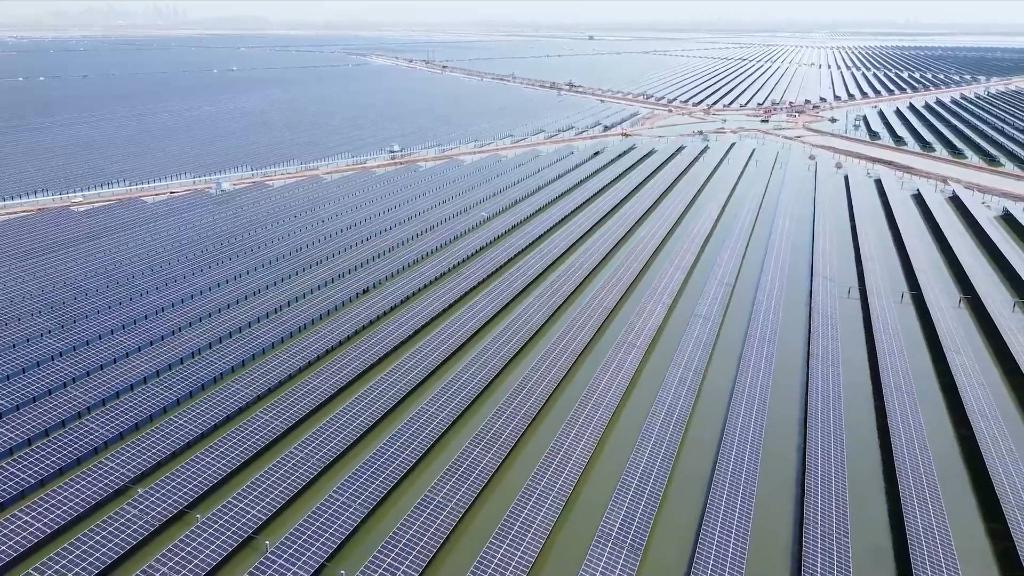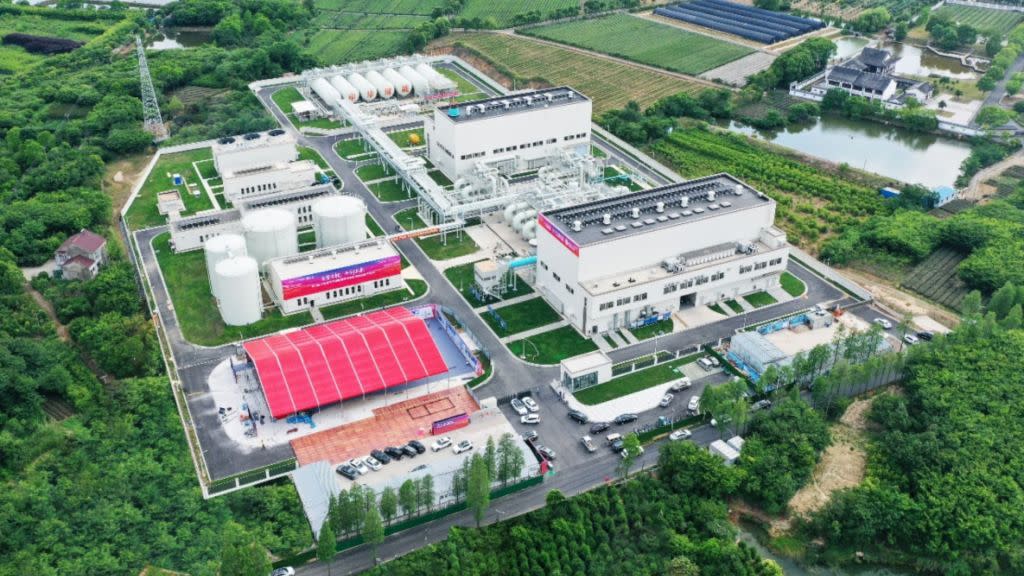
(TIANJIN, China) – China has launched the world’s largest integrated salt-solar power facility, marking a revolutionary breakthrough in renewable energy technology that could transform global power generation. The Huadian Tianjin Haijing power station, spanning 13 square kilometers, combines innovative “salt-light complementary” technology with traditional salt farming to generate enough electricity to power 1.5 million households.
The groundbreaking $2 billion project, located in China’s northern port city of Tianjin, represents a significant advance in the nation’s push toward carbon neutrality. The facility harnesses both direct sunlight and reflected light from salt flats through advanced double-sided solar panels, achieving unprecedented energy efficiency levels.
“This facility demonstrates China’s commitment to innovative clean energy solutions,” said Dr. Zhang Wei, lead engineer at the Huadian Power International Corporation. “By combining salt production with solar power generation, we’ve created a dual-purpose facility that maximizes land use while minimizing environmental impact.”
The power station’s one-gigawatt capacity produces approximately 1.5 billion kilowatt-hours of electricity annually, while simultaneously maintaining salt production capabilities. Officials estimate the facility will reduce carbon dioxide emissions by 1.25 million tons per year.
In this article
- 1 Beyond Solar
- 2 Thorium Molten Salt Reactor
- 3 Global Implications
- 4 Economic Impact
- 5 Looking Ahead
- 6 Comparative Cost Analysis
- 7 Technical Innovations and Efficiency
- 8 Environmental Impact Assessment
- 9 Storage Solutions and Grid Integration
- 10 International Collaboration and Technology Transfer
- 11 Economic Multiplier Effects
- 12 Challenges and Future Developments
- 13 Future Roadmap
Beyond Solar

China’s salt-energy initiatives extend beyond solar applications. In Jiangsu province, authorities have commissioned the country’s first salt cavern for compressed air energy storage, located 1,000 meters underground. The facility boasts a 300 MWh capacity and 60 MW generating capability, offering a novel solution to renewable energy storage challenges.
The Jiangsu Jintan Salt Cavern Compressed Air Energy Storage Project is situated in Changzhou, Jiangsu Province, utilizing underground salt caverns for compressed air storage. The first phase of the project, which includes a 60 MW compressed air energy storage unit, was officially put into operation on May 26, 2024. The second phase is currently under construction and aims to expand capacity significantly.
“The salt cavern storage system represents a crucial breakthrough in addressing intermittency issues associated with renewable energy sources,” explained energy analyst Li Mei from the Beijing Energy Research Institute. “It’s a vital component in China’s comprehensive energy strategy.”
The initial phase can store 300 MWh of electricity per cycle, while the expanded facility will have a total capacity of 2.8 GWh. This allows for significant energy storage and retrieval capabilities. The second phase will feature two units with a combined output of 700 MW, making it the largest compressed air energy storage facility globally in terms of power generation capacity. The project boasts a power conversion efficiency of over 60%, ensuring effective energy storage and retrieval without emissions.
The facility is designed to have zero emissions throughout its operation. It is expected to save approximately 270,000 tonnes of standard coal annually and reduce carbon dioxide emissions by around 520,000 tonnes.
Thorium Molten Salt Reactor
In a parallel development, China has announced plans to construct the world’s first thorium molten salt nuclear reactor in the Gobi Desert. This next-generation nuclear technology promises enhanced safety features and improved efficiency compared to traditional uranium-based reactors.
The molten salt reactor design operates at atmospheric pressure and includes inherent safety mechanisms that prevent meltdowns, marking a significant advancement in nuclear power generation. Industry experts project operational costs at approximately $2.00 per watt, potentially undercutting traditional nuclear power plants.
The construction is set to begin in 2025, with the reactor expected to be operational by 2030. This timeline follows the completion of a smaller experimental reactor that began operation in 2021.
The reactor is a thorium-based molten salt reactor (TMSR), designed to utilize liquid thorium fuel instead of traditional uranium fuel. This approach aims to enhance safety and efficiency in nuclear power generation.
The initial demonstration reactor will have a thermal output of 60 MW, with an electrical generation capacity of 10 MW. It will operate at high temperatures, around 700°C.
The reactor will use a mixture of thorium and uranium tetrafluoride (UF4) as fuel, with thorium reserves estimated at about 50 kg. The design includes a eutectic mixture of lithium fluoride and beryllium fluoride (FLiBe) as the coolant.
Unlike traditional reactors that require water for cooling, this molten salt reactor uses liquid salt and carbon dioxide to transfer heat, which simplifies the cooling process and enhances safety. The project includes plans for recycling over 80% of spent fuel materials, with remaining radioactive waste solidified into glass for secure disposal.
This initiative aligns with China’s broader objectives to transition to cleaner energy sources and reduce reliance on coal, addressing environmental concerns related to air pollution and carbon emissions.
Global Implications
International energy experts view China’s multi-pronged approach to salt-based energy as a potential game-changer for global renewable energy development. The technology could be particularly valuable for coastal regions worldwide, where similar salt-light complementary systems could be implemented.
“China’s innovations in salt-based energy technologies could accelerate the global transition to renewable energy,” said Dr. Michael Anderson, senior fellow at the International Renewable Energy Institute. “The combination of power generation with existing industrial processes represents a new paradigm in sustainable development.”
Economic Impact
The salt-energy initiatives are expected to create thousands of jobs while fostering the development of new industrial clusters. Local authorities report significant economic benefits, with the Tianjin facility alone generating an estimated $300 million in annual revenue through combined electricity and salt production.
Looking Ahead
Chinese officials have indicated plans to expand salt-based energy technologies across other coastal regions, with several projects already in development. The success of these initial projects has attracted international attention, with several countries expressing interest in adopting similar technologies.
As global pressure mounts to reduce carbon emissions and transition to renewable energy sources, China’s salt-energy innovations could provide a blueprint for sustainable power generation worldwide. The convergence of traditional industries with cutting-edge renewable technology may well represent the future of clean energy production.
Comparative Cost Analysis
The economic viability of salt-based energy systems has become a crucial factor in their adoption. Below is a comprehensive comparison of energy generation costs across different technologies:
| Energy Source | Cost per MWh | Initial Investment | Operational Life |
|---|---|---|---|
| Salt-Solar Hybrid | $45-60 | High ($2B+) | 25-30 years |
| Traditional Solar | $35-55 | Medium | 20-25 years |
| Coal | $65-150 | Medium | 30-40 years |
| Traditional Nuclear | $130-200 | Very High | 40-60 years |
| Wind | $30-60 | Medium | 20-25 years |
| Molten Salt Reactor | $50-70 | High | 60+ years |
*Data sourced from International Energy Agency and Chinese National Energy Administration, 2023
Technical Innovations and Efficiency
The Huadian Tianjin Haijing facility incorporates several groundbreaking technical features that set it apart from conventional power plants. The double-sided solar panels achieve up to 30% higher efficiency compared to traditional solar installations, according to project engineers.
“The reflective properties of salt flats create an ideal environment for solar power generation,” explains Dr. Sarah Chen, renewable energy specialist at Tsinghua University. “The white crystalline surface can reflect up to 80% of incident sunlight, significantly boosting energy capture efficiency.”
Environmental Impact Assessment
Recent environmental impact studies have revealed additional benefits of the salt-light complementary system:
- Water Conservation: The system requires 35% less water compared to traditional solar farms
- Biodiversity Protection: Salt pans continue to serve as important habitats for migratory birds
- Land Use Efficiency: Dual-purpose utilization increases land productivity by 160%
Storage Solutions and Grid Integration
The salt cavern compressed air storage facility in Jiangsu represents a critical component of China’s energy storage strategy. With a response time of less than 10 minutes, the system can effectively manage peak load demands and grid fluctuations.
“The salt cavern storage system achieves a round-trip efficiency of 60%, making it one of the most cost-effective large-scale energy storage solutions available,” states Wang Feng, chief engineer at the State Grid Corporation of China.
International Collaboration and Technology Transfer
Several countries have initiated partnerships with Chinese entities to explore salt-energy technologies:
- Saudi Arabia: Joint development agreement for desert-based salt-solar facilities
- Australia: Research collaboration on molten salt storage systems
- United Arab Emirates: Technical exchange program for salt cavern storage
Economic Multiplier Effects
The salt-energy sector has generated significant economic benefits beyond direct power generation:
- Employment: Creation of 12,000+ direct jobs in construction and operations
- Supply Chain: Development of specialized equipment manufacturing industry
- Research & Development: Establishment of three new research centers
- Export Potential: Estimated $5 billion in technology exports by 2025
Challenges and Future Developments
Despite the promising results, experts acknowledge several challenges:
- Technical Hurdles:
- Corrosion management in molten salt systems
- Optimization of heat transfer efficiency
- Long-term reliability assessment
- Infrastructure Requirements:
- Grid modernization needs
- Specialized maintenance facilities
- Skilled workforce development
“While challenges exist, the potential benefits far outweigh the obstacles,” notes Dr. Li Wei, director of the Chinese Academy of Sciences’ Energy Research Institute. “We’re seeing unprecedented levels of investment in solving these technical challenges.”
Future Roadmap
Chinese authorities have outlined an ambitious expansion plan:
2024-2025:
- Construction of three additional salt-solar hybrid facilities
- Expansion of salt cavern storage capacity to 1 GWh
- Pilot testing of enhanced molten salt reactor designs
2026-2030:
- Nationwide rollout of salt-energy technologies
- International technology transfer programs
- Integration with Belt and Road Initiative
This comprehensive approach to salt-based energy technologies positions China at the forefront of renewable energy innovation, with potentially far-reaching implications for global energy markets and climate change mitigation efforts.
References:
China’s first salt cavern compressed air energy storage station starts expansion, english.news.cn, 18 December 2024
Installation starts on ‘world’s largest’ compressed air energy storage unit in China, Energy Storage News, 31 December 2024
Cost of Electricity from Molten Salt Reactors, Research Gate
Safe, clean, proliferation resistant and cost-effective Thorium-based Molten Salt Reactors for sustainable development, Taylor and Francis, 06 Jun 2021
Molten Salt Reactors Market Report 2022-2032, GlobalNewsWire, 29 July 2022
RELATED: The Hidden Costs of Renewable Energy: Unmasking the ‘Free’ Energy Myth







